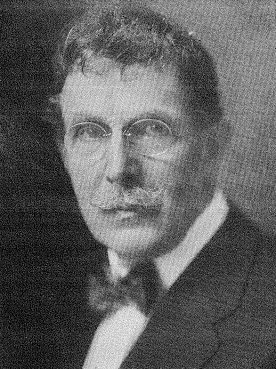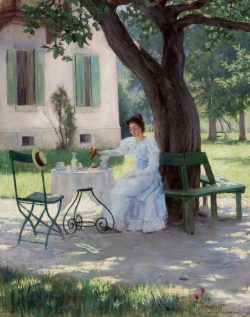Ralph Clarkson, from a photograph reproduced in Richard Teutsch, Ralph Clarkson: A Tribute (1942).

Ralph Clarkson 1861–1942
A native of Amesbury, Massachusetts, Ralph Elmer Clarkson began his art training in 1881 in Boston’s Museum of Fine Arts school and then spent four years in Paris at the Académie Julian. In 1887, his last year in Paris, Clarkson was represented in the annual Salon exhibition and was encouraged to show his work in Chicago’s upcoming Interstate Industrial Exposition annual art exhibition. Returning that year to the U.S., he lived in Hartford, Connecticut, and then in New York, where he exhibited in the National Academy of Design’s annual shows. Between 1892 and 1895 he was back in Europe, painting and studying independently. Following a visit to Chicago late in 1895, Clarkson decided to settle there, attracted by abundant opportunities for portrait commissions.
More accustomed to departures than arrivals of artistic talent, Chicagoans welcomed the accomplished, well-spoken, Paris-trained Clarkson. Having made his reputation for outdoor figural scenes and European landscapes in watercolors as well as oils, Clarkson soon established himself as one of the city’s most respected portrait painters. His sitters included prominent local artists and architects, society women, University of Chicago dignitaries, and other members of the city’s elite. His best-known work, however, remains the exotic Nouvart Dzeron, A Daughter of Armenia (1912; Art Institute of Chicago), a full-length image of one of his students. Clarkson won several important awards, and in 1910 he was elected an associate member of the National Academy of Design. He taught at the Art Institute of Chicago, served on numerous exhibition juries, and was a popular lecturer. Clarkson also occasionally wrote about art, compiling one of the first histories of painters in Chicago for a special issue of the national journal Art and Archaeology in 1921.
At least as important as his suave portrayals of Chicagoans were Clarkson’s tireless endeavors to promote art in his adopted city. Almost from the start, his studio was a gathering place for artists and their supporters, particularly when, in 1898, he became one of the first to occupy the newly opened Fine Arts Building on Michigan Avenue. At the center of an elite artistic coterie that included painters Charles Francis Browne and Oliver Dennett Grover and sculptor Lorado Taft, among others, Clarkson was a founder of such influential groups as the Cliff Dwellers club, the Art Institute’s Friends of American Art support group, and Eagle’s Nest, the art colony in Oregon, Illinois, where he often summered. He served in many local and national organizations, notably the Municipal Art League and the Chicago Society of Artists, and he was a founding member of the New York Water Color Club. At his death, Clarkson was hailed as “the helmsman” for his tireless leadership in the Chicago art world of his day.i
Wendy Greenhouse, PhD
i Richard Teutsch, “Ralph Clarkson 1861–1942,” Tri-Color Magazine 33 (May 1942): 6, in Union League Club of Chicago curatorial files.
